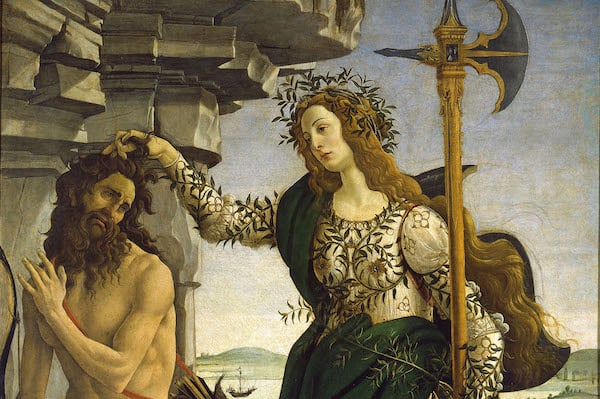
Photo: Scala, Florence , Courtesy of the Ministero Beni e Att. Cultura.
Sandro Botticelli, Portrait of a Young Man (ca.1480-85).
Photo: Courtesy of the National Gallery of Art, Washington.
Across three sharply delineated displays, “Botticelli Reimagined” considers the work and influence of the 15th century Florentine master. The Victoria & Albert Museum—an Arts and Crafts-inflected temple to the sibling status of the fine and decorative arts—puts its distinctive institutional stamp on the subject, examining Botticelli’s influence in the fields of fashion, textiles, and cinema as well as his design of powerful pictorial compositions.
The darkened walls and reflective black floors of the opening galleries address a legacy of recent references and appropriations that extend from Bill Viola’s reverential video installation to the high camp of David LaChapelle. The nightclub atmosphere invites spectacle and grand gesture as, in the hands of Warhol, Terry Gilliam, Dolce & Gabbana et al the concept “Botticelli” is reduced to an ever-tighter group of signifiers—a shell, the position of a hand, tendrils of hair—from a single painting. Sandro Botticelli’s Birth of Venus (1484-86) has become a pop cultural icon; shorthand for ideal beauty that is there to be subverted as much as she is celebrated.
Venus Dress: Look 15, Dolce & Gabbana S/S Fashion Show in Milan, Italy 1993.
Photo: Catwalking.com via Victoria & Albert Museum, London.
So firmly lodged are Botticelli’s “greatest hits” in the cultural consciousness that it is hard to imagine it were ever otherwise. Their wide renown in the early 20th century was certainly propelled by Mussolini-backed touring exhibitions of Italian masterpieces, in which Birth of Venus played a central role.
The second portion of this exhibition is dedicated to the “rediscovery” of Botticelli—and in particular of his earlier, non-religious works—in the 19th century. Elegantly arranged over two domestic-toned rooms, this section, in which William Morris, his family, and circle play a central role, is closely allied to the V&A’s own history. Here we see ardent copies of works visited on trips abroad by Dante Gabriel Rossetti and others of the Pre-Raphaelite circle. Ruskin seems to have obsessed to the point of near lovesickness over his own acquiescent, peaches and cream study of Jethro’s daughter Zipporah.
William Morris, John Henry Dearle, Morris & Co, The Orchard (1890).
Photo: Victoria & Albert Museum, London.
As well as copies, the Pre-Raphaelites acquired then-unfashionable paintings by Botticelli at a knock down rate, and drew freely from his compositions, his vivid depictions of draped velvets and gauzy silks, his instinct for both male and female beauty, and, in the case of Morris, the stylised foliage of his sylvan backdrops. The decorative fronds of myrtle and acanthus that lick around Pallas or Flora migrate quite directly into some of Morris’s pattern designs. (Both Morris’s wife Jane and daughter May performed as artist models for Botticelliesque compositions, so perhaps he was merely creating a backdrop for their domestic Primavera?)
Botticelli himself is held until the final monastery-white rooms. The Primavera (1477-82) and Birth of Venus, so spiritually present in the opening galleries, are too fragile to leave the Uffizi, but the delicate, rather melancholy Pallas and the Centaur (c.1482) made the trip, as did a quizzical, enigmatic Portrait of a Young Man (c.1490-95) from the National Gallery in Washington. From the V&A’s own collection we see the Portrait of a Lady known as Smereldina Bandinelli (1470–75), once owned by Rossetti.
Sandro Botticelli Pallas and the Centaur (1482).
Photo: Scala, Florence , Courtesy of the Ministero Beni e Att. Cultura.
While it may seem churlish to discuss provenance in the context of such compelling works, the underlying narratives of acquisition, influence, theft, attribution, and the realpolitik of the Renaissance studio system are here presented as fair game. Competing versions of a single composition—by Botticelli, by his workshop, by less skillful imitators—are placed side by side, as are similarly repetitive series of religious works. Much as the Morris household was apparently populated by doleful thick-haired beauties, the Botticelli studio seemed to maintain a batch of small tousled boys in buff and indigo smocks ready to pose as angels or St. John as commissions dictated: one can see them maturing over a batch of compositions, ditto the holy infant.
As for provenance, Rossetti is the best of a bad bunch, with Goering at the other end of the scale. And while the Pre-Raphaelites may have championed the aesthetic value of Botticelli’s work, it was left to professional authenticators such as Bernard Berenson to talk up their monetary worth.
Dante Gabriel Rossetti, La Ghirlandata (1873).
Photo: Scala, Florence/Heritage Images.
There is an unspoken underlying theme to the show relating to human beauty and to whom it serves. As all those not-quite-right 19th century copies, and some quite astonishingly ugly paintings (star prize to Arnold Böcklin) demonstrate, the nuanced beauty of Botticelli’s monumental goddesses and wistful Madonnas is hard to pin down. His Venus is not the confident brat portrayed by Uma Thurman in Baron Munchhausen, but something more tentative: closer to Rineke Dijkstra’s awkward adolescents. In Botticelli’s own time, Savonarola and his acolytes restricted the portrayal of beauty to the service of God and the church. For artists closer to our own time, beauty is a subject hard knit with notions of oppression—a received ideal based on gender binaries, or West European features.
This is an ambitious and complex show, touching on issues of religion, power, and aesthetics across five centuries. While some of the shoutier 20th century works seem like mere jolly Instagram fodder, the closing works of the show—two giant, bewitching, studies for Venus—leave all that forgotten, as so much noise.